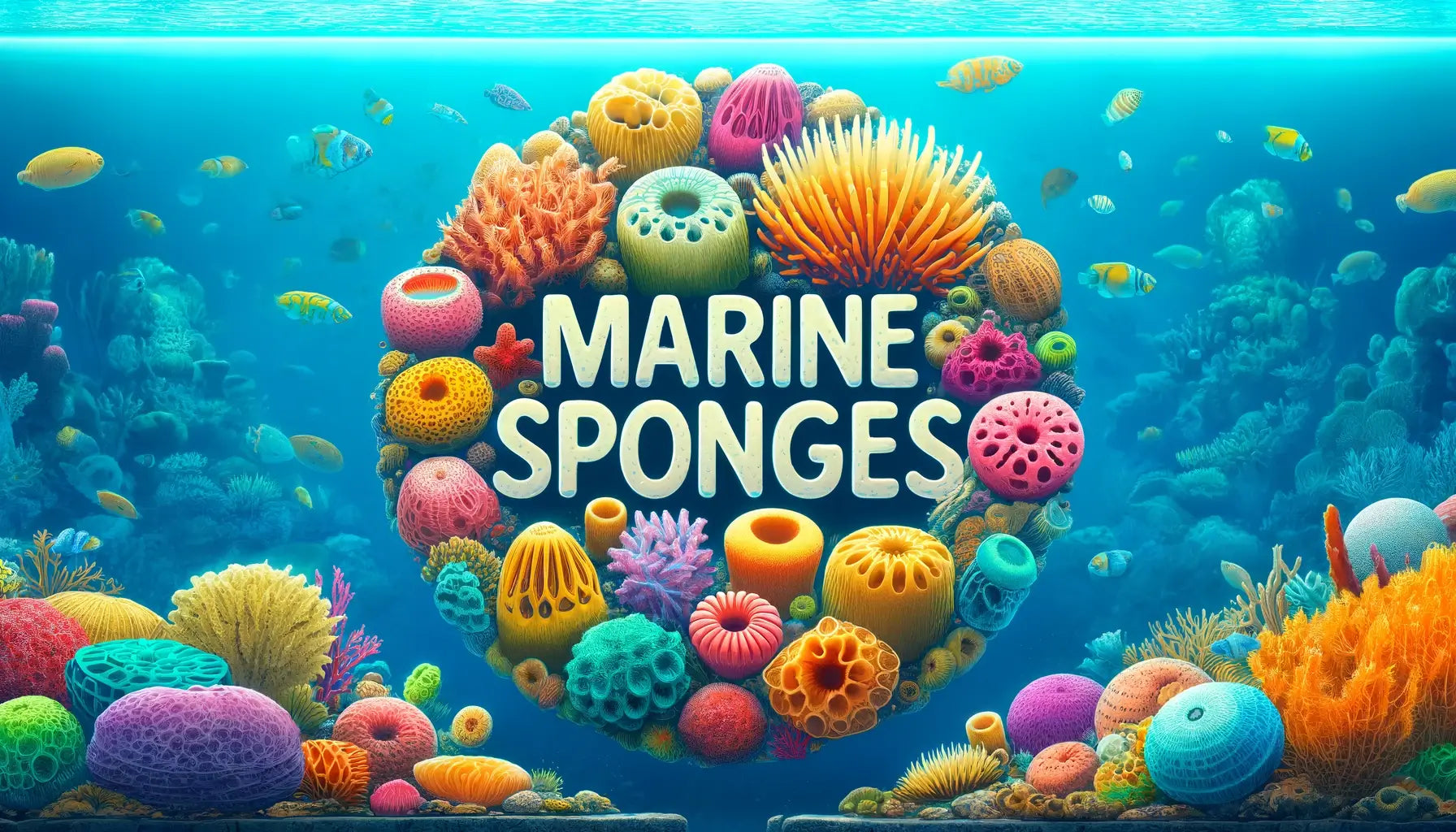Marine Sponges: The Filter Feeders of the Deep
Marine sponges are some of the most ancient and fascinating inhabitants of the ocean, known for their incredible filtration abilities and unique structures. These simple yet vital organisms play a crucial role in maintaining the health and balance of reef ecosystems. This comprehensive guide will explore the different types of marine sponges, their filtration benefits, and how to maintain them in a reef tank, providing you with the knowledge needed to successfully incorporate these remarkable filter feeders into your marine aquarium.
What Are Marine Sponges?
Marine sponges belong to the phylum Porifera, a group of simple, multicellular organisms that lack true tissues and organs. Instead, their bodies are composed of a porous matrix of cells, which allows them to efficiently filter water for nutrients. Sponges come in a wide variety of shapes, sizes, and colours, making them a visually interesting addition to reef tanks.
Types of Marine Sponges
Marine sponges can be categorised into several major classes, each with unique characteristics and appearances. Here are some of the most common types found in reef aquariums:
1. Demospongiae (Demosponges)
• Characteristics: Demosponges are the largest and most diverse class of sponges, comprising about 90% of all known sponge species. They have a skeleton made of spongin fibers and siliceous spicules.
Example Species:
• Xestospongia muta (Giant Barrel Sponge): Known for its large, barrel-like structure and ability to grow to impressive sizes.
• Spongia officinalis (Bath Sponge): Commonly used for bath sponges due to its soft and absorbent texture.
2. Calcarea (Calcareous Sponges)
• Characteristics: Calcarea sponges have a skeleton made of calcium carbonate spicules. They are typically small and less colourful than other sponges.
Example Species:
• Leucosolenia complicata: A small, white calcareous sponge found in shallow waters.
• Clathrina clathrus: A yellow calcareous sponge with a lattice-like structure.
3. Hexactinellida (Glass Sponges)
• Characteristics: Glass sponges have a skeleton made of silica and are known for their intricate, glass-like structures. They are typically found in deep-sea environments.
Example Species:
• Euplectella aspergillum (Venus Flower Basket): A beautiful, vase-shaped sponge with a delicate, glassy structure.
• Hyalonema sieboldi: Known for its long, flexible spicules that resemble glass fibres.
Filtration Benefits of Marine Sponges
Marine sponges are renowned for their exceptional filtration capabilities, making them invaluable members of reef ecosystems. Here are some of the key benefits they provide:
1. Water Filtration
• Marine sponges filter vast amounts of water, removing particulate matter, bacteria, and organic waste. This helps maintain water clarity and quality, benefiting all tank inhabitants.
2. Nutrient Cycling
• Sponges play a crucial role in nutrient cycling by consuming dissolved organic matter and converting it into forms that other organisms can utilise. This helps maintain a balanced nutrient environment in the reef tank.
3. Habitat and Biodiversity
• Sponges provide habitat and shelter for various small marine organisms, such as shrimp, crabs, and microalgae. This enhances the biodiversity of the reef tank and promotes a healthy, dynamic ecosystem.
4. Oxygenation
• By filtering water and facilitating gas exchange, sponges contribute to the oxygenation of the reef tank, supporting the respiration of other marine life.
Maintaining Marine Sponges in a Reef Tank
Successfully keeping marine sponges in a reef aquarium requires careful attention to their specific needs and environmental conditions.
Tank Setup and Environment
1. Tank Size
• A minimum tank size of 30 gallons is recommended for keeping sponges, providing ample space for water flow and nutrient distribution.
2. Water Parameters
• Sponges are sensitive to changes in water quality. Maintain stable water conditions with temperatures between 72-78°F, salinity levels of 1.023-1.025 specific gravity, and a pH of 8.1-8.4.
• Regular water changes and monitoring of nitrate and phosphate levels are crucial to prevent the buildup of waste that can harm sponges.
3. Lighting
• Most sponges prefer low to moderate lighting conditions, as excessive light can promote algae growth on their surfaces, which can smother and damage them.
• Consider placing sponges in shaded areas of the tank or using adjustable lighting to create suitable conditions.
4. Water Flow
• Adequate water flow is essential for sponges to filter feed effectively. Provide moderate to strong, indirect water currents to ensure a steady supply of nutrients and prevent debris accumulation.
Feeding and Nutrition
1. Natural Filtration
• Sponges feed by filtering microscopic particles from the water, including plankton, bacteria, and dissolved organic matter. In a well-established reef tank with a healthy population of microorganisms, sponges can often obtain sufficient nutrition naturally.
2. Supplemental Feeding
• In cases where natural food sources are insufficient, consider supplementing with phytoplankton, zooplankton, and other liquid planktonic foods to support sponge health and growth.
Compatibility with Other Tank Inhabitants
1. Fish
• Sponges are generally compatible with a wide variety of reef-safe fish. Avoid housing sponges with fish species that are known to nip at or eat sponges, such as certain angelfish and butterflyfish.
2. Invertebrates
• Most reef-safe invertebrates, such as cleaner shrimp, snails, and hermit crabs, can coexist peacefully with sponges. Be cautious with aggressive or predatory invertebrates that may harm sponges.
3. Corals
• Sponges can be placed near or among corals, provided there is sufficient space for both to thrive without competing for resources. Ensure that water flow and lighting conditions are suitable for both sponges and corals.
Popular Marine Sponges for Reef Aquariums
1. Red Ball Sponge (Lissodendoryx isodictyalis)
• Colour: Bright red
• Description: Known for its vibrant colour and rounded shape, the red ball sponge adds a striking visual element to reef tanks.
2. Yellow Finger Sponge (Aplysina fistularis)
• Colour: Yellow
• Description: This sponge has a distinctive finger-like structure and bright yellow coloration, making it a popular choice for aquarists.
3. Purple Tube Sponge (Aplysina archeri)
• Colour: Purple
• Description: With its tubular structure and deep purple color, the purple tube sponge is both beautiful and functional as a filter feeder.
4. Orange Elephant Ear Sponge (Agelas clathrodes)
• Colour: Orange
• Description: This sponge has a unique, ear-like shape and bright orange color, providing an eye-catching addition to any reef tank.
Challenges and Considerations
While marine sponges offer numerous benefits, they also come with several challenges and considerations for aquarists:
1. Sensitivity to Air Exposure
• Sponges are highly sensitive to air exposure, which can cause air bubbles to become trapped in their porous structure, leading to tissue damage or death. When handling or relocating sponges, ensure they remain fully submerged at all times.
2. Algae Overgrowth
• Excessive algae growth on the surface of sponges can smother and damage them. Maintain appropriate lighting conditions and control nutrient levels to prevent algae proliferation.
3. Predation
• Some marine species, including certain fish and invertebrates, may prey on sponges. Research the compatibility of tank inhabitants to prevent predation and ensure the safety of your sponges.
4. Water Quality
• Sponges require pristine water conditions to thrive. Regular water changes, efficient filtration, and careful monitoring of water parameters are essential to prevent the buildup of harmful substances.
Conclusion
Marine sponges are truly remarkable filter feeders that offer a wealth of benefits to reef aquariums. Their diverse shapes, vibrant colours, and exceptional filtration capabilities make them a valuable addition to any marine tank. By understanding their unique needs and providing the appropriate care, you can enjoy the beauty and functionality of these fascinating organisms. Whether you’re a seasoned aquarist or new to the reef-keeping world, incorporating marine sponges into your aquarium can enhance the health, biodiversity, and aesthetic appeal of your reef ecosystem.








